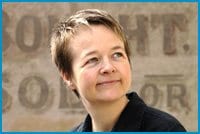Sitting in the bar of Toronto’s King Edward Hotel, Sarah Waters explains how she took a “leap of faith” with her fourth historical novel, The Night Watch. Not only did she abandon the Victorian era of her previous books (Tipping The Velvet, Affinity and Fingersmith), she experimented with time.
Waters was drawn to the post-World War II period, citing the “passion and restraint” of the 1945 film A Brief Encounter as her main inspiration. Likewise, Waters’ choice of narrative structure stems from novelist Winifred Bryher’s ’40s memoir, Days Of Mars. The book describes the bombings of London, when dust from earlier centuries was blown onto the streets. Waters saw this as a metaphor for personal histories, and became excited about moving her story backward in time. She decided to begin the book in 1947, go back to 1944, and end in 1941.
Waters was also inspired by other works that employ reverse narratives: Harold Pinter’s Betrayal, Jim Crace’s Being Dead, Elizabeth Jane Howard’s The Long View and the 2000 film Memento. “There’s even an episode of Seinfeld,” she laughs.
She enjoys the approach because it forces her to switch her focus from plot to character.
“When you’re thinking about characters’ motivations, you’re really talking about what made them what they are, their pasts. That’s how we approach the world, make sense of things. Especially with relationships it can be poignant because you’re meeting a relationship that’s past its best, and then you travel back to the point when the lovers first meet, and it’s all ‘gasp.’ And it’s very sad.”
Setting the novel in the ’40s opened up new avenues of research: sound recordings, ration books and court papers from the British Imperial Museum, films and oral histories. Because the war was “still within living memory,” she could access people who’d survived it — both exciting and frightening for Waters. “There was more pressure to get things right.” So she gave her completed manuscript to her girlfriend’s grandmother and some older lesbians to read because, “They could spot things that didn’t ring true.”
When faced with writing about the war, Waters says she was concerned about “telling fresher stories than I knew already.” Consequently, her characters go against the grain of accepted WWII narratives. One character’s lover is an anti-Semitic British soldier. “[It] was surprising to discover how much anti-Semitism there was and had been in Britain for a long time. But the war didn’t change that. That people could be anti-Germany and still be anti-Semitic was distressing.”
Waters also gives chilling accounts of prisoners (some in jail for attempted suicide or conscientious objection) stranded aboveground during bombings. The conscientious objectors range from pacifists and religious objectors to socialists and poor young men who felt like cannon fodder.
“We have lots of stereotypes about the war, especially in the UK,” says Waters. “I think there are arguments to be made that if any war was just, the war against Nazism was. But at the time it was a muddle of ideas. People didn’t get the revelations about the worst of the Nazi stuff until near the end or after. In retrospect it’s easy to put a shape on the war that it didn’t necessarily have at the time. It seemed to me people would have felt at odds with [it].”
Waters says writing the book during the invasion of Iraq gave “this extra sensitivity to what people in London had gone through and also to what people in Iraq were about to experience. It was weird to be writing about it in one period and then turning on my TV and seeing it and feeling implicated. Like lots of people in the war, I [felt] that awful sense of being caught up in a big, violent historical process and not be able to do anything.”
In terms of queer issues, Waters views the mid-20th century as more trying than Victorian times. “In the 19th century it was pre-our modern fixed ideas about homosexuality and heterosexuality. Things were more interesting because they were more flexible. But the ’40s and ’50s was the worst point because it was when the gay community was becoming established. The more you identify yourself, the more you set yourself up as a target. There was so much prejudice. You were vulnerable to being arrested, blackmailed, losing your job and kids, being sent to a psychiatrist.”
Waters’ interest in that part of gay history has grown. She plans to expand her postwar research, with a focus on the ’50s. She will also continue to experiment with the way she tells stories, “if only because it’s interesting to try something new.”
For now, she’s being kept busy with readings. Toronto was city number nine of 12 in her North American tour, which followed closely on the heels of Australia and New Zealand. The King Eddy is all Waters will see of our country, but her impression of our new government is clear, “Scary, because we always look to Canada as the sane presence next to the barmy US.”

 Why you can trust Xtra
Why you can trust Xtra


